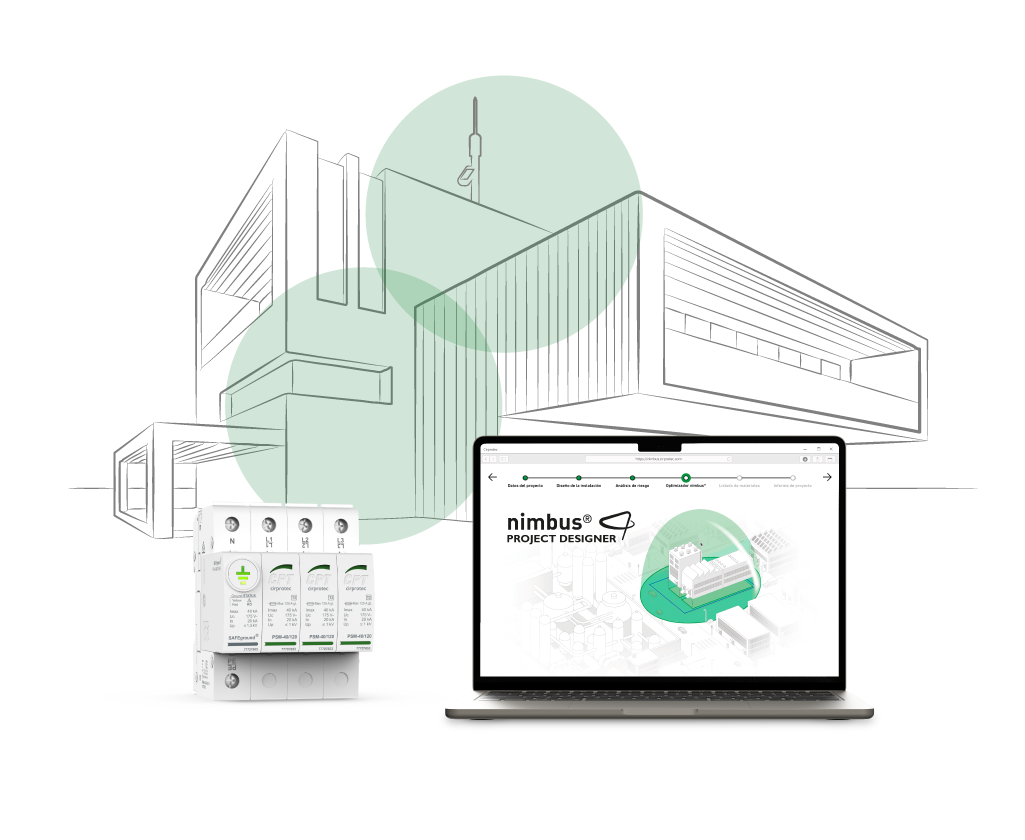El laboratorio de sobretensiones y rayos, una herramienta de innovación y excelencia
Desde su establecimiento hace más de 25 años, el laboratorio de alta tensión de...
Y lo celebramos con la nueva generación EGARA de SPDs y nueva web. Listos para proteger la transición energética.
DetallesDesarrollada en nuestros LABs para las aplicaciones y normas de la transición energética. Made in Spain con criterios de sostenibilidad.
Saber másNuestros laboratorios de tensión/corriente son fundamentales. Generamos conocimiento, patentes y certificaciones IEC/EN y UL.
DetallesMonitorización del sistema de tierras dentro del propio protector. Patentado a nivel mundial.
DescubrirProductos diseñados y optimizados para la protección del punto de recarga del vehículo eléctrico.
DescubrirLa aplicación PV & BESS es de máxima exigencia técnica y normativa. Soluciones específicas DC y AC.
Saber másDiseña la protección contra el rayo de una forma fácil, rápida y óptima.
Conoce nimbus®Y lo celebramos con la nueva generación EGARA de SPDs y nueva web. Listos para proteger la transición energética.
DetallesDesarrollada en nuestros LABs para las aplicaciones y normas de la transición energética. Made in Spain con criterios de sostenibilidad.
Saber másNuestros laboratorios de tensión/corriente son fundamentales. Generamos conocimiento, patentes y certificaciones IEC/EN y UL.
DetallesMonitorización del sistema de tierras dentro del propio protector. Patentado a nivel mundial.
DescubrirProductos diseñados y optimizados para la protección del punto de recarga del vehículo eléctrico.
DescubrirLa aplicación PV & BESS es de máxima exigencia técnica y normativa. Soluciones específicas DC y AC.
Saber másDiseña la protección contra el rayo de una forma fácil, rápida y óptima.
Conoce nimbus®Ayudamos a empresas y fabricantes a proteger sus instalaciones, equipos eléctricos y personas, gracias a nuestras soluciones estándar y personalizadas de fabricación nacional.
Los productos Cirprotec se fabrican en España y se certifican y acreditan a través de organismos independientes como Dekra, Underwriters Laboratories, Bureau Veritas y ENAC. Además de cumplir con las normativas más exigentes (UL, IEC, EN, UNE-EN, NFC...), la seguridad se garantiza con altos estándares de calidad en el proceso de producción.
Sobretensiones transitorias Tipo 1+2 en centralizaciones de contadores y aplicaciones industriales exigentes. Libre de corrientes de fuga.
Protector DPS + POP con deslastre y rearme automático por corte contador. Impedancia infinita. Esquema 2 ITC-BT 52.
Pararrayos PDC/ESE con tecnología de verificación a distancia. Mantenimiento periódico fácil en instalaciones de difícil acceso.
Monitorización de la puesta a tierra dentro del propio protector DPS Tipo 2. Sin tierra no hay protección. Patente mundial.
Sobretensiones transitorias Tipo 2+3 para drivers de luminarias de alumbrado exterior LED. Cableado Push-in fácil. Certificado ENEC.
Protector combinado sobretensiones transitorias y permanentes, con IGA. Compacto y precableado. Botón de test e indicación POP.
El software online gratuito nimbus® project designer te permite diseñar tu instalación de pararrayos. Para cualquiera que sea el grado de complejidad y extensión de la instalación, calcula automáticamente la ubicación y el número óptimo de pararrayos, sin dejar de proteger ninguna zona (salvo las de exclusión). Anexa el informe completo a la especificación del proyecto.
Para la descarga de sobretensiones transitorias, hay que tener en cuenta que sin tierra no hay protección. Refuerza la seguridad de la protección con SAFEGROUND®, el SPD patentado mundialmente que te informa sobre el estado de la instalación:

Desde su establecimiento hace más de 25 años, el laboratorio de alta tensión de...
Estamos emocionados y llenos de gratitud al celebrar el 30 aniversario de Cirprotec. Este...
Presentamos EGARA, la nueva generación de Dispositivos de Protección contra Sobretensiones (SPD) de la...
El pasado mes de febrero, tuvimos el privilegio de participar en la destacada feria...
